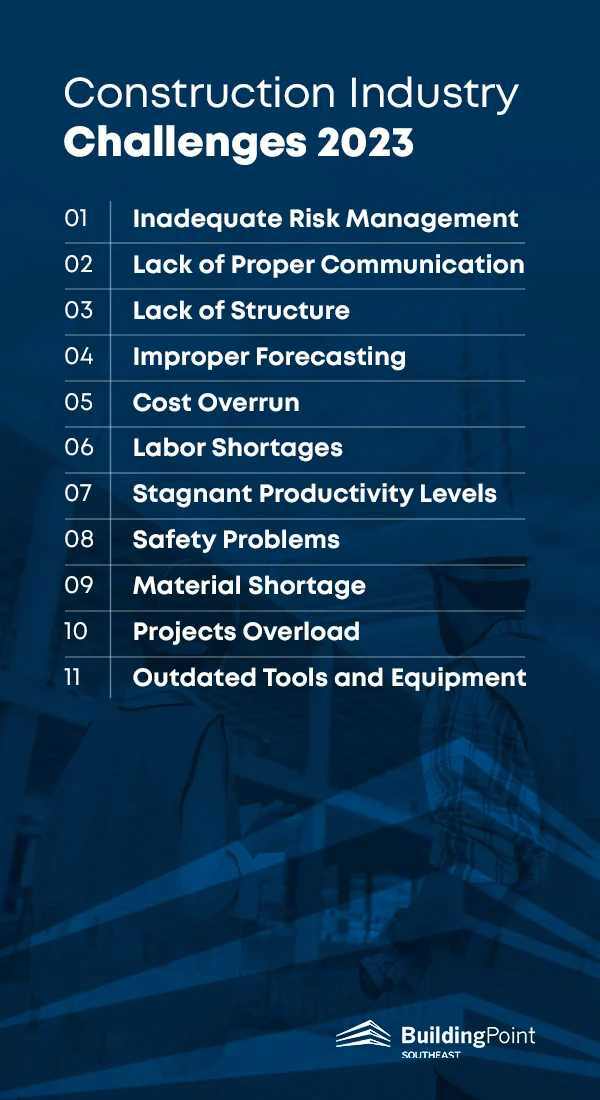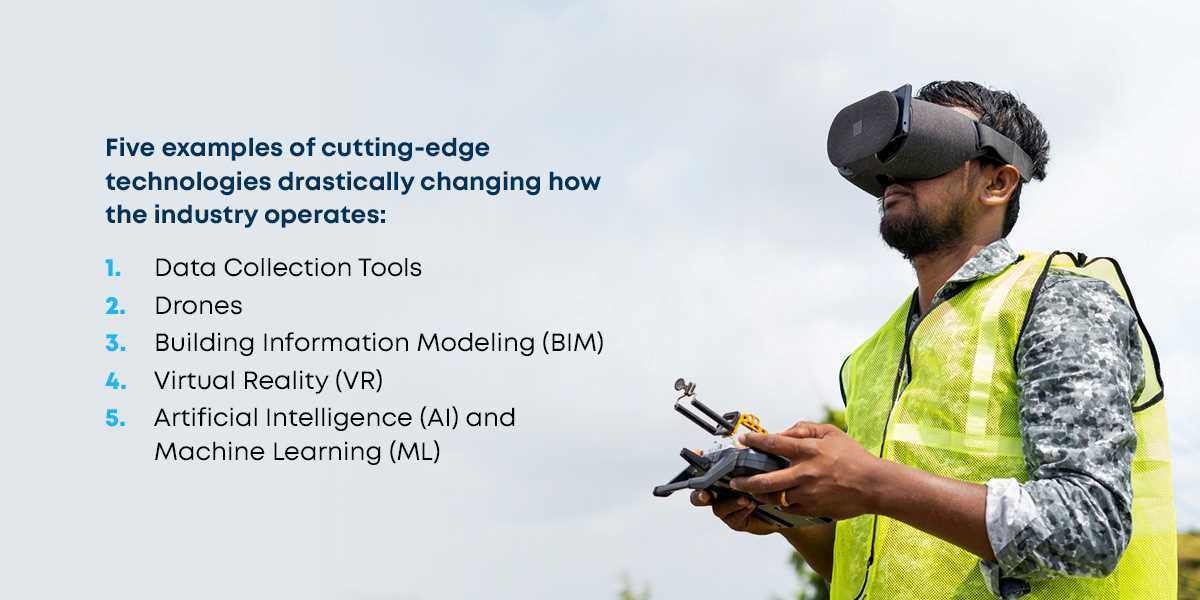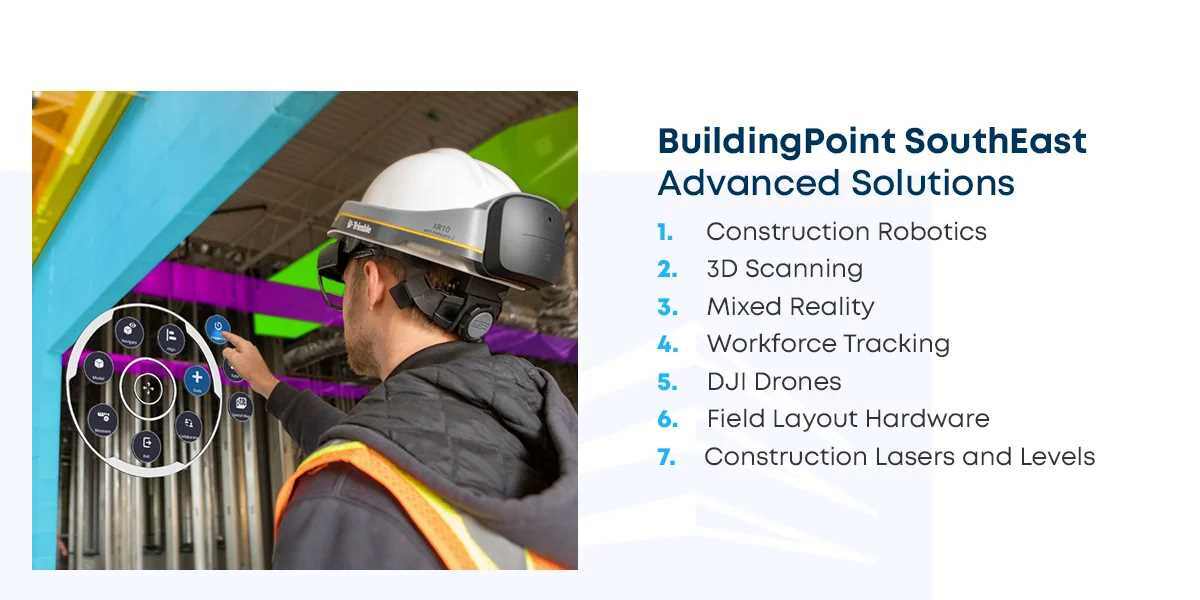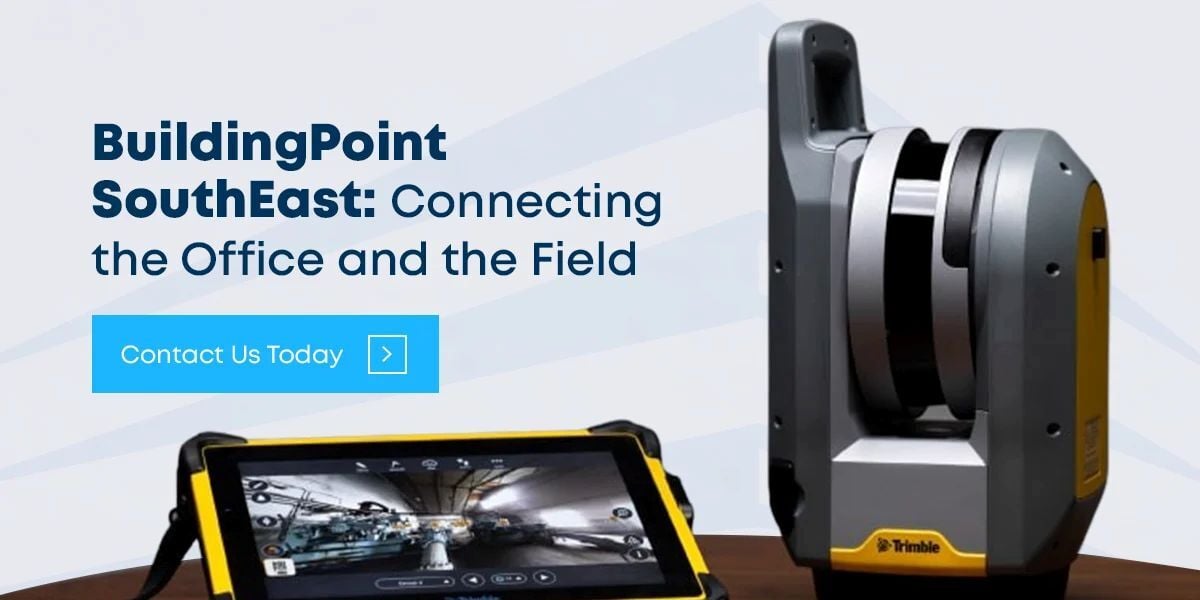Stay ahead of project and industry changes while improving efficiency with field solutions purpose-built for the entire building construction lifecycle. It's a simpler way to optimize teams and maximize results – No matter how complex the project. Decades of experience in the field gives Trimble unique insight into ways to improve the performance of field teams. From construction to specialty trades like MEP, concrete and more, Trimble field solutions promote improved quality of work. Trimble guides equipment operators to get the job done right the first time. In MEP and other trades, standardized field workflows make it easy to learn and operate sophisticated technology for layout and scanning.
Common Construction Challenges
The construction industry experiences its fair share of challenges. However, many construction companies have survived with the help of technology. Innovations such as artificial intelligence and robotics have simplified operations and made it easier to generate accurate estimates and plan projects, regardless of the level of complexity.
To build a formidable and adaptable business capable of overcoming problems, read through this guide to the common challenges industry players face and the best practices to guide you and your team.
Construction Industry Challenges 2023
Here are the top 11 construction problems and solutions:
1. Inadequate Risk Management
Contractors and project managers must implement measures and safeguards for long-term risks. These measures help you prepare for challenging situations. However, problems can build when you leave short-term risks out of the equation. Unexpected setbacks can affect your long-term goals regardless of how minor they may seem.
Research indicates that only 27% of executives in the construction industry consider quantitative risk analysis tools as fundamental to their operations. The same study shows that 37% of construction executives missed budget and scheduled performance targets by 20% or more when the COVID-19 pandemic hit.
Whether dealing with unreliable subcontractors, handling changes in client specifications or resolving minor disputes with stakeholders, an inadequately anticipated and prepared-for hurdle can stall a project for a long time. That's why the best construction agencies develop contingency plans and invest in risk assessment and management to help them reduce downtime.
2. Lack of Proper Communication
Communication is integral to construction projects, especially when you delegate work to subcontractors. Project managers and general contractors who operate without proper communication channels may encounter defects or delays if updating subcontractors is challenging. Keeping clients in the loop is also necessary for better customer service.
A functioning team has a clear communication ladder. All stakeholders should have easy access to information and forums for asking questions. This way, leaders can hold subordinates accountable and allow other participants to act proactively.

3. Lack of Structure
Embarking on a construction project without structure is like a building without a plan — it just doesn't work! Every construction project is unique, and setting clear goals and realistic expectations is essential. The team should have a straightforward action plan to drive operations.
For example, besides assigning deadlines for subcontractors, a contractor should assess the operational framework to ensure the process will help the team finish at the expected completion date. This is particularly true when minor targets and strategies are set at each construction stage.
Performance management is necessary if you want to succeed in the construction industry. Managers should assign tasks to each team member and break down bigger, project-wide tasks into daily targets. This method enables you to manage bigger groups and complex operations within the project.
4. Improper Forecasting
Clients may have big expectations, and it's your responsibility to manage them, especially when they are unrealistic. As a contractor, your goals typically align with your clients' goals, and they impact your plan and strategy. Regardless of the influencing factors, your goals must be achievable. The best way to evaluate these demands is proper forecasting.
Like risk management, forecasting helps project managers prepare adequately for short- and long-term challenges. Break forecasts into daily, weekly and monthly pursuits and assess how long each milestone will take. Seek a second opinion where necessary and consider all other factors that may create obstacles. Suggest an alternate plan with practical timelines and budgets. Managing expectations from the beginning helps you retain control throughout the project.
5. Cost Overrun
The construction industry relies heavily on cash flow, but cost overruns remain among the most significant challenges. Typically, this challenge signals deeper issues in project management and is often from budgets and schedules being incorrectly set at the early stages of the project. Sometimes, forces beyond human control impact these elements. However, the cause may also be an inaccurate analysis.
The competitive nature of the bidding process may cause project stakeholders to submit inaccurate proposals, which haunts the execution from start to finish. Similarly, project design defects result in disputes that divert resources from the project. Fortunately, these hurdles are avoidable.
General contractors can leverage construction software to reduce errors and create accurate project estimates. Additionally, contractors and owners may agree on the performance duties and scope of work in the contract phase. Such engagements should be appropriately documented, including the warranties, risk allocation and dispute resolution procedures and processes for unforeseen challenges. This added scrutiny reduces corrections and offers a clear guide for the contractor.
6. Labor Shortages
Acquiring skilled labor has been a significant challenge in the construction industry since 2008. In April 2020 alone, the construction industry lost about 975,000 jobs due to the COVID-19 pandemic. The situation has improved steadily, yet some general contractors still have labor challenges. Professionals like estimators, supervisors and engineers were lost to other careers while retirement took care of the rest. This phenomenon impacts innovation and the ability to fulfill contracts.
Technology has made most contractors agile and competitive in this unpredictable landscape. Large and small companies leverage drones for supervision and use estimating software to make accurate assessments. Technology has also improved talent acquisition, simplifying identity and evaluation of skills.
7. Stagnant Productivity Levels
Unlike other industries, the construction industry has witnessed a slight improvement in productivity over the years. Despite the sector contributing 13% to the global GDP, it only realized an annual productivity growth rate of 1% between 2000 and 2020.
However, the pandemic unexpectedly became the guiding star for most companies, accelerating an overdue transformation in the industry. Most construction executives agree that several changes are already manifest in the United States.
According to the same research by McKinsey, research and development (R&D) spending among the top 2,500 construction companies worldwide has risen by about 77% since 2013. Companies willing to learn about and incorporate advanced technology into construction operations will most likely perform better than those still relying on traditional approaches.
8. Safety Problems
According to the United States Chamber of Commerce's commercial construction index, only 35% of contractors say worker health and safety are their top concerns. Yet, the construction industry has the most fatal workplace injuries, with 21.2% in 2020. Considering that humans play significant roles in the industry, health and safety issues require more attention than they get.
Adequate training remains one of the most efficient solutions for ensuring safety on the job site. Thus, safety training should be regular and designed to instill discipline in all workers. Executives should include all workers in the safety exercise and comply with all the regulatory requirements. Include the best safety protocols and best practices in your organization.
Most construction-related injuries and casualties are preventable, especially when safe work practices are strictly and vigilantly enforced. Detailed and comprehensive on-site inspections before, during and after construction projects are also recommended.
9. Material Shortage
Another supply chain problem in the construction industry is materials shortage, which contractors cite as among the most significant COVID-19 impacts, according to the commercial construction index. Lack of construction materials invariably increases prices and causes projects to stall.
In such challenging times, contractors require more accurate material estimates and planning to prevent making emergency orders. When in doubt about a project's profitability, use cost value reconciliation (CVR) by comparing your business's actual spending on the project with the projected spending budget at critical points in the timeline. This can help you decide which project requires more attention.
10. Projects Overload
Construction companies are often project-hungry because more projects generally translate into increased finances. However, it is crucial to consider whether you have the means to execute the tasks. The practice of winning bids and hiring on the fly strains the operation. Taking shortcuts to complete one job quickly so you can move on to the next can also diminish the quality of work.
Conducting a pre-assessment based on the size and demands of the project can help avoid significant roadblocks. Use that overview to identify your capabilities. Assess which tasks you can complete yourself and those you require further assistance to execute. Delegate roles to your team members and create a priority list.
11. Outdated Tools and Equipment
Workers can only perform optimally when they can access the right equipment. Modern construction demands require contractors, subcontractors, project managers, architects and engineers to invest in tools that increase operational efficiency and accuracy. This technology necessitates partnering with professionals to provide on-site, virtual and classroom training to guide your crew to use the hardware and software.

Leveraging Technology in Construction
Technology has become ubiquitous in all industries and is no longer reserved for innovators. Modernizing your processes has real, practical applications and benefits, especially if you want to maintain a competitive advantage. Here are five examples of cutting-edge technologies drastically changing how the industry operates:
1. Data Collection Tools
Running a construction company without data will likely leave you a little lost. However, many companies avoid using data due to a lack of understanding of its use or the challenging nature of its collection. Top organizations use data collection software to gather vast amounts of high-quality data with little to no human effort. This saves time, provides accurate results, streamlines workflow, improves safety and compliance, and enhances reporting.
2. Drones
Drones are one of the most widely used technologies in the construction industry. They enable you to conduct quick and accurate site surveys with less effort and money. Drones can also capture images in more complex terrain and areas otherwise inaccessible to humans. Their high-resolution cameras can create interactive 3D or topographic models and maps with precise measurements.
3. Building Information Modeling (BIM)
BIM is the foundation of digital transformation in the engineering, architectural and construction industries. It is a holistic approach to creating and managing information for a built asset. BIM integrates structured, multidisciplinary data to produce a digital representation of an asset throughout the entire development life cycle.
BIM enhances collaboration by allowing each expert to add their pieces to the same model instead of reducing them to multiple versions of 2D paper drawings. The model evolves instantly as stakeholders contribute, streamlining processes and increasing efficiency. BIM also simplifies problem-solving during your construction project's design and planning phases by automating clash detection and offering a complete project picture.
4. Virtual Reality (VR)
VR allows you to design and simulate construction projects with an interactive computer-generated user experience. You can create building designs with BIM and walk around them using VR, giving your team and clients a realistic idea of what the project will look like once completed. Leveraging this technology reduces the need for changes and improves safety on the project site. It also simplifies complex projects, saving you time and money you'd otherwise spend on corrections.
5. Artificial Intelligence (AI) and Machine Learning (ML)
AI and ML have vast applications in the construction industry. They can help companies realize value throughout the project life cycle, including bidding, designing, financing, procurement, construction, asset management and business model transformation. Regardless of the area of application, the result is generally more precise and efficient than human efforts.

BuildingPoint SouthEast Advanced Solutions
BuilingPoint SouthEast offers cutting-edge solutions in multiple areas, including the following:
1. Construction Robotics
Trimble's Spot the Dog offers autonomous robotic scanning solutions that fully integrate Boston Dynamics' Spot Robot with the Trimble X7 3D laser scanner and Trimble FieldLink software. This strategic alliance eases your operations by safely, conveniently and accurately performing repetitive tasks such as site scans and progress monitoring.
2. 3D Scanning
Use reliable scanning tools to capture as-builts, perform comprehensive data analysis and prepare new construction or renovation models for the best possible results. The game-changing X7 3D laser scanner can provide an auto-calibration routine to ensure data accuracy, reduce overall cost and eliminate downtime. With the RealWorks software, you and your team can conduct end-to-end point cloud processing and analysis and scan to BIM.
3. Mixed Reality
Mixed reality allows you and your team to experience reality and virtual elements simultaneously. It lets general contractors and other construction professionals efficiently visualize, review and share 3D designs with a comprehensive suite of extended reality products carefully designed for your construction needs.
4. Workforce Tracking
Securing job sites and controlling labor costs are crucial aspects of construction management, especially given the challenges associated with labor since the 2008 recession and the safety concerns. However, performing manual workforce tracking exercises can be complicated and time-consuming. The best solution is to deploy Trimble's site and workforce management solutions for increased visibility, control and security at your job site.
5. DJI Drones
Aerial mapping and surveys are incomplete without high-powered drones. DJI drones allow you to accomplish tasks more quickly, safely and efficiently. The portability of these devices makes them ideal for construction projects and complex environments. Drones enable you to cover more ground and get more done!
6. Field Layout Hardware
The field layout solutions are ideal for all project sizes. They are designed to extend and improve your layout capabilities. For example, the Trimble Ri is the most accurate, scalable and automated robotic total station with self-calibration features for easy set-up. And if you're looking for a Global Navigation Satellite System (GNSS) capable of handling the most demanding survey environments, the Trimble R780 GNSS is what you need.
7. Construction Lasers and Levels
Working with equipment and tools you can trust in your construction projects significantly impacts your success. That's why securing construction lasers and levels that provide detailed and accurate measurements have never been so welcomed. From line-level lasers to pipe lasers and auto-levels, ensure you use the highest quality tools to increase your return on investment.
BuildingPoint SouthEast: Connecting the Office and the Field
BuildingPoint SouthEast is an exclusive Trimble dealer providing the best solutions to players in the construction industry since 2016. We offer only the finest products and services tailored to scale your business and streamline operations. Our clients also benefit from individualized on-site support and training. Learn more about how we can help you make your business more agile and competitive. Contact us today!







